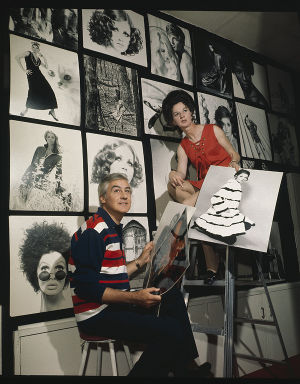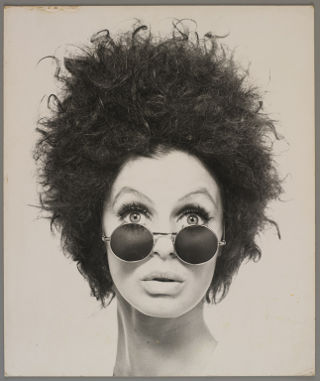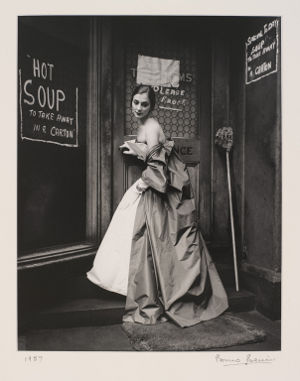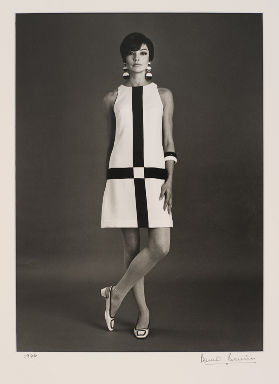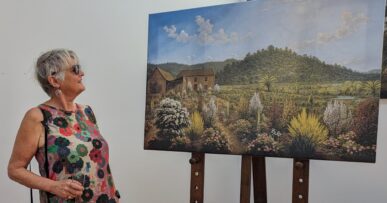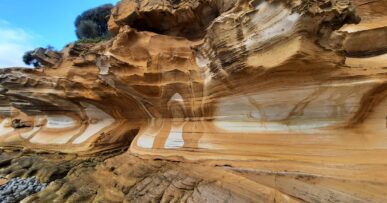A book, Creating the Look: Benini and Fashion Photography accompanies the exhibition.
Benini’s passion for photography meant capturing the crucial fashion shot at the precise moment, providing movement, action and drama, while never overshadowing the model, the clothing or accessories that were his subjects.
Since Benini’s main medium was the fashion pages of newspapers, many of the images are in black and white.
A starkly captivating photo of a 1960s black and white dress, inspired by Mondrian and with strong squares and rectangles, is offset by the contrasting roundness of dangling black and white earrings. The model, the clothing and the accessories are the complete focus. There is little background.
But Benini used background when it was need for the purpose of Creating the Look. There’s a surreal image of a glamorous woman in evening dress entering a Depression Era soup kitchen and an image of a model posing at a re-created Cobb and Co Coach Staging Post.
The photographic sets are sometimes real, sometimes constructed. They vary from construction sites to circuses, from indoors to outdoors, and from Parliament House, Melbourne to the city of Rome or Portobello Road London.
But as curator Anne-Marie Van de Ven shows us, with Creating the Look, the background is not just what you see behind the elegant subject. The curator has also delved into the background process behind each shot.
When the Powerhouse Museum acquired the Benini photographic archive from his widow Hazel Benini, she discovered material that made her aware of the strong influence of Hazel on Bruno’s work. Van de Ven realised that effectively Bruno and Hazel were a creative partnership.
Hazel Benini’s creative career began in art school in Dunedin New Zealand. She later applied her artistic talents to the planning and implementation of window displays for Melbourne retailers.
So when Bruno started borrowing Hazel’s sets and props, he may have seen what his modern-day curator saw, that Hazel had framed her windows like a photographer frames his shots.
The model and the dress or hat, or shoes or hair were the fixed elements of Bruno’s photographic brief. But in the background, Hazel was actively working to establish the other elements that would help in Creating the Look.
When they started sharing business premises, she increasingly became his stylist, location scout, set creator and ideas-woman extraordinaire. Hazel in turn used some of Bruno’s photos in her window displays, pioneering the use of blow-up fashion photographs in shopfronts.
The curator kept delving and her questions led Hazel to her recollections, photos, memorabilia and newspaper clippings into her own private publication The Life and Times of Bruno Benini, 1925 to 2001.
There are only six copies in existence. Hazel’s original manuscript and extracts from it, feature in both the exhibition and the book of Creating the Look.
A striking feature of the exhibition is an installation of a constantly-changing maze of mirrors and light boxes, with Benini’s fashion photography is projected in close ups and blow ups.
As the images flash on and off, there is a sense that you are there with Bruno Benini, with an illusion of the rapid movement of a lens shutter, the change of angle as he changes viewpoint, or zooms in and out on his subject. You feel something of the frenetic pressure to capture the moment, as the light changes and time passes. The atmosphere is reinforced by a voice over from Bruno as he calls triumphantly:
“I’ve got you. Finito!”
Hazel Benini said that while photographing, you would often hear him use phrases like, “wonderful, wonderful wonderful”. Or, “look happy happy”. Beautifully reminiscent I think of the click, click, click of a camera shoot.
Other delightful features of the exhibition were a re-creation of his photographic lab and one of the studio sets he’d used, complete with the backdrop and the tripod and camera he’d used for a particular shot. It included a reproduction of a small gondola in which the model (then) and the museum attendee (now) can be photographed. There was also a tribute in some exhibits of recent Australian fashion photography to the influential role of Benini’s style.
The Benini Creating the Look exhibition showed me the foreground and background of fashion photography, in the photographs themselves, but also in its explanation of a successful creative partnership. It very successfully links the beautiful photographic images with the stories behind the photos. I can say that I found the exhibition “wonderful, wonderful!”
Finito!

